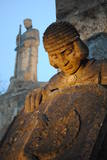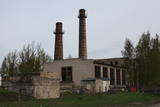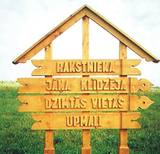| Нo | Название | Описание |
|---|---|---|
|
Как большое населенное место Саулкрасты начало образовываться в конце 19-го века, когда маленькие рыбацкие поселки – Нейбаде, Петерупе и Катринбаде стали популярным местом для отдыха и купания жителей Риги. Это вскоре поспособствовало строительству дач. На развитие курорта также повлияло открытие водного сообщения между Ригой и Саулкрасты в 1905-м году. Были построены новые курзалы, рестораны и развивалась другая инфраструктура, связанная с курортом. В летнее время отдыхающие могли развлечься на мероприятиях, баллах и концертах с участием рижских оркестров. Следующим этапом развития курорта стало шоссе и железнодорожная линия между Ригой и Саулкрасты, построенные в 30-х годах 20-го века. Советское время охарактеризовалось строительством домов отдыха, санаториев и новыми дачными домиками. Саулкрасты получают статус города. Сегодня Саулкрасты привлекают не только белым песчаным пляжем, но и различными ежегодными общественными мероприятиями, тропой Солнечного заката и Белой дюной, уникальным музеем велосипедов, Морским парком и местом для купания «Центр», площадью Саулес и другими объектами. |
||
|
National partisans commanded by Rihards Pārups were very active during World War II between Vietalva and Jaunkalsnava. The team was disbanded in 1946. The dugout is at a location that is hard to find and access. It is in the nature reserve of the Veseta Wetlands Swamp. The wood pathway that leads from the East is often hidden by reeds during the summer. During the fierce winter of 2010, the roof of the dugout collapsed, but local enthusiasts plan to reconstruct it. Alongside the dugout is a white cross inscribed with the names of the partisans who lost their lives here.
|
||
|
Tas atrodas pie „Burtnieku” mājām Īlē, kur viņš dzīvojis no 1837. – 1845. gadam. Tēvs Juris Barons apglabāts Īles kapsētā. Savu vārdu nemirstīgu Krišjānis Barons darījis, vācot, sistematizējot un sastādot Latvju Dainu krājumu. Tautasdziesmas jeb dainas ir mazi, ritmiski dzejolīši, parasti četrrindes. Pie Latvju dainu vākšanas Barons pavadījis sava mūža lielāko daļu – apmēram 25 gadus gandrīz dienu pie dienas. |
||
|
В историческом центре Гулбене ‒ в восстановленном здании конского манежа усадьбы Вецгулбене, который раньше являлся крупнейшим крытым манежем в странах Балтии, ‒расположена четырехзвездочная гостиница и ресторан. Посетителям предлагается обширное сезонное меню и бизнес-ланчи. Латышская кухня: Холодный летний суп, стейк из бедра барашка, маринованная нога кролика, жареная голень утки, клубничный суп с мороженым. |
||
|
Brāļu kapos apbedīti aptuveni 2000 karavīru. Pirmos kritušos strēlniekus — Andreju Stūri, Jēkabu Voldemāru Timmu un Jāni Gavenasu — apbedīja 1915. gada 15. oktobrī. Sākot ar 1915. gadu, kapos sāka apbedīt Pirmā pasaules kara kaujās kritušos strēlniekus, vēlāk Februāra revolūcijas laikā nošautos kareivjus. Stučkas valdības laikā 1919. gada pavasarī šeit apbedīja Brīvības cīņās pret vācu vienībām un Dienvidlatvijas brigādi kritušos latviešu strēlniekus. Pirmās Latvijas brīvvalsts laikā Brāļu kapos apbedīja ap 800 Latvijas armijas kareivjus un virsniekus. 1941.—1942. gadā Brāļu kapos apbedīja 15 nacionālos partizānus, kā arī pārapbedīja komunistiskā režīma terora upurus. Līdz 1944. rudenim šeit apbedīja arī vairākus desmitus bijušās Latvijas armijas virsnieku un karavīru, kuri bija dienējuši Latviešu policijas bataljonos un Latviešu leģionā. Abās pusēs ieejas vārtiem (augstums 10 metri, platums 32 metri) divas jātnieku skulptūru grupas (augstums 3,3 metri). Liepu gatve (205 metri) savieno vārtus ar galveno terasi, kuras centrā novietots 1 metru augsts mūžīgās uguns altāris, bet abās pusēs ozolu birzis. No terases abpusējas kāpnes ved uz regulāri veidotu kapulauku. Tā malās atrodas divas "Mirstošo jātnieku" skulpturālās grupas (augstums 3,6 metri), vidus daļā atrodas augstcilnis "Kritušie brāļi". Pret katru kapa vietu novietota smilšakmens vai plienakmens plāksnīte ar kritušā uzvārdu un vārdu vai uzrakstu "Nezināms". Ansambli noslēdz 6 metrus augsta siena ar Latvijas apriņķu un pilsētu vēsturiskajiem ģerboņiem. Pie sienas atrodas četri senlatviešu karavīru tēli, kas simbolizē Latvijas novadus - Kurzemi, Zemgali, Vidzemi un Latgali, bet tās centrā uz 9 metrus augsta sienas masīva paceļas monumentāla figūra "Māte Latvija", kas noliekusi vainagu pār kritušajiem dēliem. Brāļu kapu memoriālais ansamblis ir izcirsts no Allažu šūnakmens, izmantots arī Itālijas travertīns un smilšakmens. Pirmmetu izstrādāja tēlnieks Kārlis Zāle, arhitekts Aleksandrs Birzenieks, Pēteris Feders un Andrejs Zeidaks. |
||
|
Котельная военного порта годами использовалась для обеспечения отопления в городе. Объект принадлежит Лиепайским теплосетям, заброшен, территория не охраняется.
|
||
|
This territory is on both sides of the central section of the Raķupe River. On the banks of the river, there are many different meadow habitats, as well as massive oaks growing in the places of former farmsteads which are uninhabited by now. This is an important place for rare plants and animals. There is no tourism infrastructure for visitors in the area. Visitors who are especially interested in the environmental cognition are advised to visit the territory in attendance of experienced local guide. Raķupe is not usable for water tourism because of tilts of trees and beaver dams. |
||
|
В "Смилшкалнских" садах выращивают черную смородину, ежевику, малину, рябину, облепиху и другие ягоды, из которых производится домашнее вино. В подвале бывшего замка Кулдигского ордена предлагается три различные дегустации вин (до 25 человек). Большие группы принимаются в амбаре усадьбы Падурес. |
||
|
„Упмали”. Место родительского дома писателя Яниса Клидзейса. Клидзейс
написал 8 романов, 11 сборников рассказов, 2 сборника эссе и обзоров о католи-
ческо-латышском менталитете людей своей родной Латгалии. По роману „Дитя
человеческое” Янис Стрейчс снял фильм (с таким же названием) на латгальском
языке. Фильм приобрел любовь зрителей и признание кинокритиков не только в Латвии, но и за рубежом.
|
||
|
Впервые в исторических летописях Валмиера упоминается в 1323 году. До XIII века это место входило в состав латгальского государства Талава. Строительство средневекового Валмиерского замка началось в начале XIII века, а в 1283 году между Гауей и Ратсупите поднимается церковь. Экономическому развитию населенного места способствовало нахождение рядом с Псковом и торговыми путями Тербатас - Новгород. В XIV - XVI вв. Валмиера входит в Ганзейский союз. От войн, эпидемий и пожаров XVI – XVIII вв. город существенно изменился. Во второй половине XIX века начинается экономический расцвет города. Этому способствовал и построенный в 1866 году деревянный мост через Гаую и открытая в 1899 г. железная дорога Рига – Псков. В 1944 году исторический центр города был разрушен. В послевоенные годы в городе функционируют большие промышленные предприятия, например, Валмиерский завод (также и в наши дни) стекловолокна. Современная Валмиера – это экономический, образовательный и спортивный центр Видземе. |
||
|
Meklējama Nīcgalē, starp Rīgas – Daugavpils šoseju (A 6) un Daugavas krastu. Baznīcu cēla (neogotikas stils) pēc muižnieka Henriha Plātera - Zīberga iniciatīvas 1862. - 1863. g., veltot to Jaunavas Marijas dzimšanai. Kā jau daudzas citas baznīcas, arī šī ēka un tās interjera priekšmeti cieta 1. pasaules kara laika notikumos. To atjaunoja 1922. gadā. Baznīcas iekārta ir saglabājusies no 19. gs. 60. gadiem, bet, centrālā altāra augšdaļu pārbūvēja 1957. gadā. Dažus gadus vēlāk - 1961. g. uzstādīja ērģeles. |
||
|
This is the thickest wild pear tree in Latvia. The tree is particularly beautiful when it is blossoming.
|
||
|
The nature park near the town of Ogre is a popular place for leisure, hiking and, in the winter, cross-country skiing. Most of the park is covered with coniferous trees that are on a long and comparatively narrow line of hillocks with steep sides – another element of nature left behind in Latvia by the Ice Age. Many different plants can be found here. The Jaunogres castle hill is one of the most distinct hillocks in the area. |
||
|
Augstrozes pilskalna taka atrodas ainaviskā vietā, gleznainā 13. gadsimta pilskalnā, kas apvīts ar teikām un leģendām. No pils drupām paveras labākais skats uz lielisko ainavu, ko veido Augstrozes Lielezers un Ziemeļu purvi.
|
||
|
Nahe der Beerkopfdüne ist im Frühling 2006 „ein Brand der Jahrhunderte” gewessen. Es wurde der hundert Jahre alte Wald in der Fläsche von 235h ausgebrannt. Ein Pfad mit Holzbelag. |
||
|
Located by the old Daugava bed ravine, Sērene parish, Jaunjelgava region, the house "Lazdāres". The holiday home has three apartments, each with its own kitchen, bathroom and everything you need for a great stay in the countryside. As well as a party hall for up to 20 people. Located 3 km from Aizkraukle and one kilometer from the newly built highway P76, which connects Riga with Jēkabpils. Waiting for guests who want to enjoy the silence and summer in the countryside. Families with children. Reservations for a week and longer with discounts. |
||
|
Bērzciema Lagūna ir atpūtas vieta zvejnieku ciematā Bērzciemā. Tiek piedāvātas divas teltis, katra ir 28 kvadrātmetrus liela, ar visām nepieciešamajām ērtībām, tostarp divguļamo gultu un atpūtas zonu. Viesu rīcībā ir arī pašapkalpošanās virtuve, āra duša un piknika vietas. Pēc iepriekšējas vienošanās vienā teltī maksimāli var izmitināt 4 personas. Piedāvājumā ir arī velosipēdu un SUP noma, telšu vietas un peldvieta jūrā. Glempings atrodas Enguras ezera Dabas parkā, kurā ir vairākas dabas takas, kā arī Engures ezera dabas taka ar savvaļas dzīvniekiem un putnu novērošanas torni un orhideju taka.
|
||
|
Маршрут предусмотрен для любителей активных пеших походов, которые хотят путешествовать по самой мощной речной долине Балтии, осматривая и ощущая. Маршрут начинается в Сигулде, которую с давних пор называют «Видземской Швейцарией». В окрестностях Сигулды открываются одни из красивейших видов в Латвии. Маршрут пересекает глубокие овраги многих притоков Гауи и открывает берега реки, которые в масштабах Балтии известны мощными обнажениями песчаника девонского периода. Природные тропы Лигатне – это единственное место в Латвии, где в условиях, максимально приближенных к естественной жизни в природе – в широких вольерах – можно увидеть живущих в латвийских лесах диких животных. Правда животных и следы их деятельности можно увидеть и в дикой природе, отправляясь по лесам и тропам национального парка «Гауя». Maršruta informācija no Latvijas Lauku foruma |
||
|
Единственное место в Латвии, где реставрируют старые и изготавливают новые органы, а также шарманки. Группам интересующихся мастера рассказывают об истории изготовления органов, принципах, механизме действия инструментов. Мастерская была оборудована в 2004-м году в бывшей конюшне пастората. Мастерская принадлежит Янису Калниньшу, он является также руководителем работ. |
||
|
В 3 км к югу от центра Юркалне, у старой (гравийной) дороги Лиепая – Юркалне находится место, где располагалась бывшая Феликсбергская трехлетняя мореходная школа (1871 - 1902 г.). Так как от здания ничего не сохранилось, ее место обозначено сколоченной из дуба лодкой и двумя деревянными столбами, на которых вырезаны древние знаки рыбацкой собственности. |
||




























